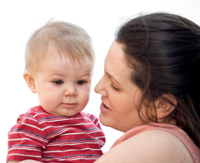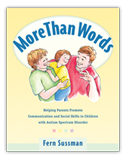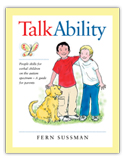A Closer Look at Social Communication Difficulties of Children with Autism Spectrum Disorder
By Fern Sussman
More Than Words® Program Director

As a parent of a child on the autism spectrum, you want to help your child communicate and interact with others. To provide the right support, you need to understand how communication typically unfolds so you can spot the differences between typical communication development and the delayed or different communication development in your young child with ASD. Once you know what milestones are important for successful communication, you’ll have a good idea of what to do to help your child.
 What is communication? Much more than words!
What is communication? Much more than words!
It is highly likely that your definition of communication includes “talking” or “words.” And while it’s true that talking is a key component of communication, true communication is much more than words. Communication is the use of both nonverbal behaviour (eye gaze, facial expression and gestures) and verbal behaviour (speech or spoken language) to tell others what you want, to express feelings, to share ideas and to solve problems, big and small.
Being a successful communicator means not only sending clear messages, but being tuned in to other people’s messages. These messages need some interpretation, whether this involves understanding gestures, facial expressions or even the meaning behind words (think of a friend who says, “That’s fine” when you cancel a dinner date and you know she really means, “I am furious with you!”). Successful communicators know the unspoken rules of conversation, which include waiting and listening while someone else speaks and then following up with a comment or a question that relates back to what the speaker has just said. We all need to learn these unspoken rules of conversation to become effective communicators.
The Development of Social Communication
By age 5, children should be very skilled in the kind of social communication described in the above section. However, this ability to understand and use the rules of conversation doesn’t just happen all at once. It’s acquired in baby steps from the moment a child is born. Awareness of some early social and communication milestones will help you understand what’s missing in your child’s communication and the kind of help he needs at each stage of his development.
Social Communication in the First Year of Life
In the first few months of life, children are fascinated with faces, especially their mother’s face. Being interested in his mother is the first step a baby takes toward becoming a social being. Soon after, the baby takes turns babbling back-and-forth with his mother in what looks like a little conversation without words. Besides imitating sounds, the infant starts to copy actions he sees his mother doing, like blowing raspberries and clapping hands. He is especially responsive to his mother’s sing-song voice and prefers her voice over the sounds around him. Towards the end of the first year of life, the baby becomes even more sociable, getting interested in the things his caregivers point to and sometimes even saying his first words.
If your child isn’t looking at you or paying attention to your voice, he’s missing some early opportunities on the road to becoming a social communicator.
 Tips to Help Your Child Pay Attention to You (from the Hanen More Than Words® guidebook)
Tips to Help Your Child Pay Attention to You (from the Hanen More Than Words® guidebook)
- Always try to be face to face with your child
- Exaggerate your intonation when talking to your child so that you’re more interesting than anything else in his environment. For example, “Look! The baby’s CRYing! The baby is SAD (sound sad).”
Social Communication in the Second Year of Life
Even children who aren’t talking by the beginning of the second year of life are sending clear messages with gestures. They begin by giving or holding up objects with the intention of getting their parents’ attention and progress to gestures like shaking their heads “no” and waving “bye-bye.” By about 14 months, infants are pointing to the things they want and by about 16 months, they are pointing to things they want their parents to look at – just to share what’s of interest to them. This last kind of pointing is the foundation for sharing information with words. In time, instead of pointing and making a sound when he is fascinated by a baby crying, the child will be able to say, “Baby crying.”
By the end of the second year, children are communicating primarily with words (they can say about 300 words) for a variety of reasons, including asking questions and sharing something they think the other person will be interested in.
If your child isn’t using and understanding a range of gestures, including pointing, he’s going to have challenges interpreting and sending non-verbal messages.
 Tips to Help Your Child Use Gestures (from the Hanen More Than Words® guidebook)
Tips to Help Your Child Use Gestures (from the Hanen More Than Words® guidebook)
- Hand your child something that he wants (e.g., a favourite treat or toy) in a transparent container that is hard for him to open and wait for him to give it back to you (a gesture) so you can open it for him
- Sing songs that have gestures in them (e.g., If you’re happy and you know it, clap your hands, wave goodbye, nod your head).
Social Communication in the Preschool Years (3-5 years)
During the preschool years, children increase their vocabulary size to around 6000 words and speak in longer sentences. But the biggest changes during these years are what children talk about. No longer focused on just the here and now, preschoolers use language to talk about the future, the past and to problem-solve. In conversations, they often show consideration for their conversational partner by making a comment or asking a question about something the other person has already said.
If your child is talking, but only talking about the things that he’s interested in or doesn’t connect what he says to what the other person says, he’s showing you that he’s having trouble tuning in to people and still needs to work on using communication for social purposes.
 Tips to Help Your Child Tune In to Others (from the Hanen TalkAbility™ guidebook)
Tips to Help Your Child Tune In to Others (from the Hanen TalkAbility™ guidebook)
- In everyday situations, talk about the differences in what people like and think. For example, you can ask your child to help you pick cereals in the grocery store, based on what he knows about the preferences of family members. This helps him think about what others think and like.
- When you read books with your child, talk about what the character in the book is thinking and feel.
In conclusion...
No two children are alike in their social or communication development, but there are certain milestones which children must reach in order to be successful communicators. Having delayed or missing milestones doesn’t mean that your child can’t make significant improvement. Early intervention that focuses on your child’s social and communication strengths and challenges can make all the difference.
Did you like this article?
- Find more helpful information in our Autism Section
- Sign up for The Hanen Newsletter, and we'll let you know as soon as new autism-related content becomes available on our website
The Hanen Centre has developed two excellent programs to help parents of children on the autism spectrum learn how to promote their child’s communication development in everyday conversations and routines.
For more information on the More Than Words® program for parents of children with autism spectrum disorder, click here.
For more information on the TalkAbility™ program for parents of children with high functioning autism, click here.
To find out more about how Hanen can help you help children communicate, click on the links below: